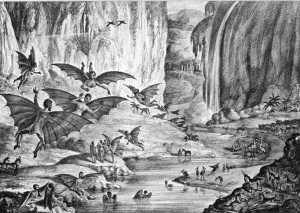Good morning, Whitewater.
Monday in the Whippet City will bring a one-third chance of thunderstorms and a high of eighty-nine.
UW-Whitewater Chancellor Richard Telfer is scheduled to deliver a state of the university speech today at 10:30 AM. This evening, the Whitewater Unified School District governance committee meets at 6:30 PM, with a regular meeting following at 7 PM.
On this day in 1835, the Great Moon Hoax begins:

August 28, 1835 (4th article of 6).
Via Wikipedia.
“The Great Moon Hoax” refers to a series of six articles that were published in The Sun, a New York newspaper, beginning on August 25, 1835, about the supposed discovery of life and even civilization on the Moon. The discoveries were falsely attributed to Sir John Herschel, perhaps the best-known astronomer of his time.[opinion]
The story was advertised on August 21, 1835, as an upcoming feature allegedly reprinted from The Edinburgh Courant.[1] The first in a series of six was published four days later on August 25….
“GREAT ASTRONOMICAL DISCOVERIES LATELY MADE BY SIR JOHN HERSCHEL, L.L.D. F.R.S. &c. At the Cape of Good Hope [From Supplement to the Edinburgh Journal of Science]”
The articles described fantastic animals on the Moon, including bison, goats, unicorns, bipedal tail-less beavers and bat-like winged humanoids (“Vespertilio-homo“) who built temples. There were trees, oceans and beaches. These discoveries were supposedly made with “an immense telescope of an entirely new principle.”The author of the narrative was ostensibly Dr. Andrew Grant, the travelling companion and amanuensis of Sir John Herschel, but Grant was fictitious.
Eventually, the authors announced that the observations had been terminated by the destruction of the telescope, by means of the Sun causing the lens to act as a “burning glass,” setting fire to the observatory.[2]
Google-a-Day asks a question about geography:
What group of islands in the Pacific are part of the same volcanic zone and was named from the Greek words meaning “small” and “island”?
